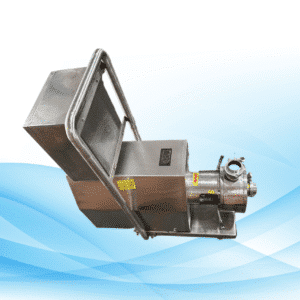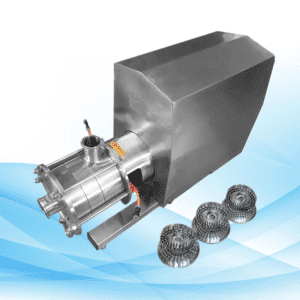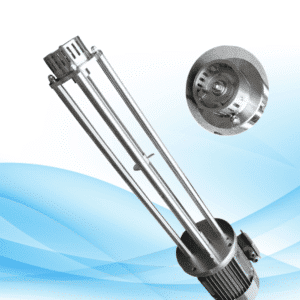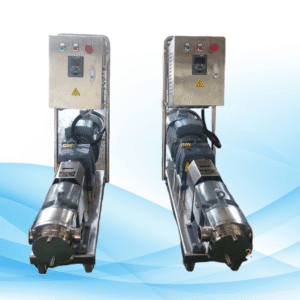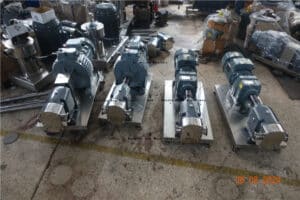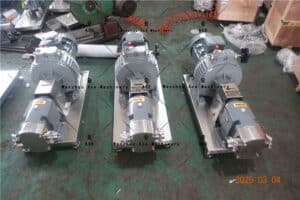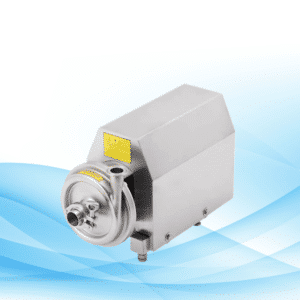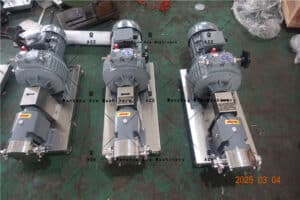Rotary Lobe Pumps Overview
Rotary lobe pumps form an integral part of different sectors, such as food pumping and wastewater pumping. If you are an industry occupier, a scholar, or even just an interested person, understanding the mechanisms behind rotary lobe pumps along with specific application practices is seed to everything you do. This piece intends to delve deeper into the workings of a rotary lobe pump, its features, their widespread use, and how it became an essential tool where effective and dependable fluid management is a necessity.

What Are Rotary Lobe Pumps?
Rotary lobe pumps are among the positive displacement pumps designed to move liquids by trapping an amount of fluid and forcing it through the system. Instead, the rotary lobe pumps utilize fixed pumps consisting of two or more lobes that rotate in opposite directions to create a cavity within. This cavity is moved perpendicular to the pump body, allowing movement of the liquids from the passage entrance to the exit.
Essential Features of A Rotary Lobe Pump
An understanding of the following major components of a rotary lobe helps in better understanding its withstanding functions and operations.
Rotor Lobes
The chamber parts that are powered using a rotary motion. Their shapes can be oval, figure-eight shaped or others.
Casing
The casing surrounds the rotors and holds the liquid which is to be pumped.
Shafts
The shafts provide a connection from the motor to the lobes, allowing for their rotation.
Inlet and Outlet Ports
Points where the fluid gets into and out of the pump.
Spinning Lobe Pump Working Principle
It is quite easy to understand the working of a rotary lobe pump:
Inlet
During the rotation of the rotors, the lobes generate a negative pressure at the inlet by expanding cavities.
Compression
After the expansion cavity gets filled in, the positive pressure created at the outlet causes rotation which gently pushes the liquid in the chambers to rotate.
Discharge
A continuous rotation of the rotors causes the fluid in the chambers to be expelled via the output port.
The movement is smooth and continuous, this means the rotary lobe pumps are best suited for pumping soft or shear sensitive liquids.
What Are The Benefits Of Using Rotary Lobe Pumps?

One of the first things that set apart rotary lobe pumps from the competition is the non-pulsating fluid transfer, which works wonders for industries that require precision. A few advantages of rotary lobe pumps are as follows:
1. Capable of Handling High Viscosity Fluids
Rotary lobe pumps are capable of pumping both relatively low viscosity fluids like water, as well as extremely high viscosity fluids like syrups. Such considerations lead to rotary lobe pumps being the preferred surgical device in pharmaceutical and food industries, as well as in the chemical industry.
2. Non-Sensitive Pumping Mechanism
Since the operation of a rotary lobe pump is non-pulsating, it is ideal for a number of shear sensitive materials such as creams, juices, and other soft sensitive substances.
3. Pump Self Priming Functionality
Another advantage that would serve the rotary lobe pump with great value is the ability to self-prime. This would give the pump the independence to begin moving the fluid without additional support systems, making it reliable for situations that require the handling of fluids often.
4. Cost Effective Maintenance
The downsides of a rotary lobe pump are little to none due to the sheer mechanical simplicity that plagues these devices. Because there aren’t many moving parts, there are very few chances of the equipment breaking down. Normal maintenance consists of cleaning and lubrication sessions that lead to rotary pumps being very cost-efficient.
5. High Efficiency
These pumps use less energy and put forth less effort to achieve a higher output. They have a long lifespan due to low component breakage and, at their most efficient, give a reliable rate of flow, making them suitable for these tasks.
Common Applications of Rotary Lobe Pumps
Rotary Lobe Pumps are utilized across a wide range of industries that require precise operations in fluid mechanics. Some of the common applications include:
1. Food and Beverage Industry
In food processing, rotary lobe pumps are employed to handle viscous fluids such as honey, sauces, and yogurt. Their gentle pumping actions aid in the preservation of these delicate products.
2. Chemical Processing
The chemical industry has a large variety of aggressive or abrasive substances. Thus requiring special pumps for transferring the chemicals, solvents, and slurries without being compromised. Rotary lobe pumps can carry out these tasks efficiently.
3. Pharmaceutical Manufacturing
The pharmaceutical sector demands high sterility measures and careful handling of materials. As such, rotary lobe pumps are frequently used to transfer ingredients and suspensions while minimizing contamination.
4. Wastewater Treatment
With the advancement of technology, rotary lobe pumps have become a staple in the movement of thick sludge, waste materials, and even abrasive particles during wastewater treatment. Their robustness makes them ideal for such challenging tasks.
The Benefits of Rotary Lobe Pumps Compared to Others
Although there are many types of pumps on the market, every pump type comes with its own set of advantages, more so when compared to centrifugal or diaphragm pumps. So let us have a brief overview of lobe pumps versus the rest in terms of certain applications:
Comparison Between Rotary Lobe Pumps And Centrifugal Pumps
- Efficiency: Unlike rotary lobe pumps, centrifugal pumps will sometimes struggle in varying pressures and viscosities. This is because rotary lobe pumps are capable of maintaining a relatively constant flow rate.
- Handling Viscosity: Unlike centrifugal pumps, rotary lobe pumps are good at handling thick fluids.
- Maintenance: Due to their high-speed operations, centrifugal pumps may be prone to clogging or wearing. This means that high maintenance is required. In contrast, rotary lobe pumps are much more maintenance-friendly.
Comparison Between Rotary Lobe Pumps And Diaphragm Pumps
- Flow Consistency: Rotary lobe pumps guarantee a continuous flow. In contrast, diaphragm pumps can be more destabilizing as they tend to pulse.
- Suitability for Slurries: Compared to lobe pumps, diaphragm ones are less competent at handling slurries and thick materials.
What Sets Rotary Lobe Pumps Apart When Compared with Other Positive Displacement Pumps?
Rotary lobe pumps are categorized under the positive displacement pumps family of which piston and gear pumps are also a part. There are peculiarities associated with rotary pumps which remain absent in other types of pumps:
Low Fluid Shear
Rotary lobe pumps are a better fit for sensitive pumping applications as compared to piston and gear pumps because they exert a lower shear rate to the fluid.
Simpler Clean
The construction of the rotary lobe pumps allows them to be disassembled and cleaned quicker and more efficiently than other types of pumps which is of utmost importance in sanitary applications.
Better at Handling Large Solids
Compared to most positive displacement pumps, which cannot handle large solid particles, rotary lobe pumps can. This makes them suitable for industrial applications involving wastewater treatment.
Preventative Maintenance and Troubleshooting for Rotary Lobe Pumps
Although rotary lobe pumps are quite reliable, they do require some degree of care on a regular basis to ensure that everything stays in good working order. Here is how you can make sure that the performance of your pump remains seamless:
1. Frequent Physical Checks
Regularly look over the lobes with the casing of the pump for damage, especially those that are abrasive. They tend to cause leakage which can cause other issues in the fluid system.
2. Maintain Proper Lubrication
Applying oil to the moving parts of the machinery can help minimize wear and tear. Also, check to see that the lubricant used can work well with the pump material and the liquid being worked on.
3. Check for Leakage
Leakages can indicate that the seals or gaskets are due for replacement. Any flaws in these parts must be addressed immediately in order to prevent contamination – and to keep operations working properly.
4. Clean the Pump on a Scheduled Basis
Hygienic boundaries should be observed in industries such as food processing or pharmaceuticals where special cleaning is required. Performance of the pump is also positively impacted through regular maintenance.
Final Words
Conclusively, there is no denying that rotary lobe pumps are effective and versatile in virtually all industries focused on pumping shear-sensitive fluids or oils with high viscosity. Knowing how a rotary lobe pump functions will further your understanding of its value in applications ranging from food processing to the treatment of wastewater. With the right pump, seamless processes and improved efficiency go hand in hand with cost control.
Frequently Asked Questions (FAQs)
1. Which fluids are the most suitable for a rotary lobe pump?
Rotary lobe pumps can handle pumps of different fluids such as thick liquids, slurries, sensitive materials, and abrasive fluids to name a few.
2. How frequently should my rotary lobe pump be maintained?
Maintenance encompasses checking for wear and tear, lubricating the moving parts, cleaning the pump, and checking the seals and gaskets. This should be done routinely depending on how often you use the pump.
3. What industries utilize rotary lobe pumps?
The food and beverage, pharmaceutical, chemical, and wastewater treatment industries routinely use rotary lobe pumps.
4. What differentiates a rotary lobe pump from a gear pump?
A rotary lobe pump is preferred over a gear pump when handling sensitive materials because it provides lower shear and handles the materials more gently while gear pumps are better for thinner liquids because they provide more shear.
5. What steps can I take to enhance the longevity of my rotary lobe pump?
The service life of a rotary lobe pump can be improved by conducting routine maintenance, not allowing the pump to run dry and using the right type of lubricants.

